

Prick Your Finger. The1940s-wwiiathome.wikispaces. 1940s Fashion from the WWII Years. Posted by Edelweiss Patterns on June 16, 2012 In recent weeks I have been feeling very inspired by the 1940s, and I am toying with the idea of making a WWII era outfit for the Fourth of July.
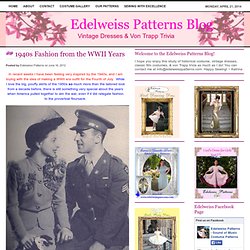
While I love the big, pouffy skirts of the 1950s so much more than the tailored look from a decade before, there is still something very special about the years when America pulled together to win the war, even if it did relegate fashion to the proverbial floursack. There was something so timeless and poignant about the way our nation sacrificed personal dreams and goals to ensure our freedoms would continue for generations.
While we may be many years removed from WWII, we can still connect with the feelings of the men and women who waved goodbye so that the family life they had known would go on. For some reason WWII is really the only war of American history that I feel I can connect with in this way. Writing - Melissanre's 1940's Exhibition. Writing proposal How did women respond to taking over men's jobs and having a war affect the way they dressed?
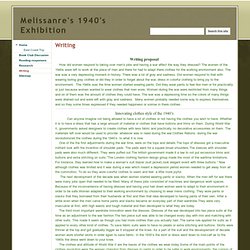
The women of the 1940s were left to work at the place of men and there for had to adapt there clothes for the working environment also. The war was a very depressing moment in history. There was a lot of gray and sadness. Did women respond to that with wearing boring gray clothes or did they in order to forget about the war, dress in colorful clothing to bring joy to the environment. Innovating clothes style of the 1940’s. Rationing Fashion: Women's Clothing of WWII. The last successful invasion of England was achieved by William the Conqueror in 1066, but that doesn’t mean that Great Britain is invulnerable.

It is an island nation with a large, dense population, and not a lot in the way of forest plantations or mineral wealth. The resulting economic pressures led Britain to seek raw materials through theftpillage colonial expansion. In 1939, the defense industry and the consumer economy both relied on goods shipped from overseas, either from Britain’s colonies or from other countries. Germany had spent the interwar period developing viable and deadly submarine technology.
With the outbreak of war, Germany began to attack Atlantic shipping lanes, disrupting the imports Britain relied upon. Merchant convoys were protected by the British and Canadian naval and air forces, and, after 1941, by American forces as well. 1940s Fashion. 1940s Fashion Was All About How to Look Great in Tight Times... 1940s fashion s motto can be considered Total Utilisation, The Age of the Uniforms or Make Do and Made as British Vogue Pronounced in 1940s.

In Europe, as the Governments took control of the wartime purse strings, rationing enforced an era of required minimalism. The luxurious film star look of the 30s now viewed as flashy, unpatriotic and vulgar. In 1943 Vogue warned: ‘You’ll have fewer clothes because you have not the time, money and coupons to clutter up your life with non-essentials... You’ll have simpler clothes because in these days anything elaborate looks silly.’ Restriction orders outlawed any wasteful cutting and excess trimmings, ration limited consumerism and the Utility scheme offered Government-approved clothing at fixed prices. C20th Fashion History 1940s - Utility Clothing 1940s. 1940s Rationing - Utility Clothing Fashion and Costume History Uniforms and Patriotic Fashion Looks During the Second World War Paris produced restrained clothing to match the economic atmosphere.
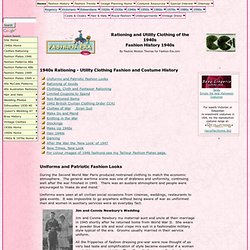
The general wartime scene was one of drabness and uniformity, continuing well after the war finished in 1945. There was an austere atmosphere and people were encouraged to 'make do and mend.' Uniforms were seen at all civilian social occasions from cinemas, weddings, restaurants to gala events. The war years in Crook. Make & Mend. Make Do and Mend, and a Give-Away. "Make Do and Mend" is a phrase from World War II that was more commonly used in Great Britain during WWII.

Food and clothing were rationed after about 1940, and frugal living was a necessity. sourceDid you have a grandmother or a great, or a great-great who saved string, reused aluminum foil and saved vegetable seeds from the past seasonal crops? Of course, you say. sourceOne of my favorites messages about mending and reflecting on aspects not only referring to simply repairing clothes, but also speaking to the issue of healing spirits was written by Susan Kittredge, a pastor who read her message on NPR back in 2008.
Her entire story can be found here, and it is well worth the read. ...I have come to relish the moments when I sit down and, somewhat clumsily, repair a torn shirt, hem a skirt, patch a pair of jeans, and I realize that I believe in mending. It's time to make do and mend. We're told the recession is coming to an end, but money is still tight and people are losing their jobs every day.
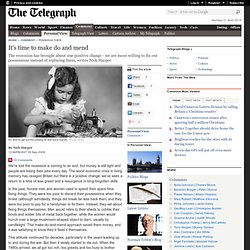
The worst economic crisis in living memory has ravaged Britain but there is a positive change: we’ve seen a return to a time of less greed and a resurgence in long-forgotten skills. In the past, honest men and women used to spend their spare time fixing things. They were too poor to discard their possessions when they broke (although admittedly, things did break far less back then) and they were too poor to pay for a handyman to fix them. Instead, they set about fixing things themselves. Men would retire to their sheds to cobble their boots and solder bits of metal back together, while the women would hunch over a large mushroom-shaped object to darn, usually by candlelight. Introduction to English embroidery. Detail from the Syon Cope, early 14th century.
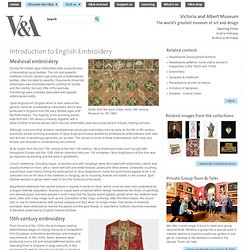
Museum no. 83-1864 Medieval embroidery During the middle ages embroidery was a popular way of decorating luxury textiles. The rich and powerful medieval Church owned huge amounts of embroidered textiles, often donated by wealthy. BBC Inside Out - Crafts in crisis. A Crafter At Sea. Damn, Knit & Blast It: …knit happens! Etsy, Folksy and the mania for making crafts. 8 November 2012Last updated at 05:04 ET By Vanessa Barford BBC News Magazine Arts and craft-orientated websites are now showcasing a bewildering array of homemade, pop culture-influenced knick-knacks.

Craftmania is among us. Why? It's a toy mouse clad in leather armour.